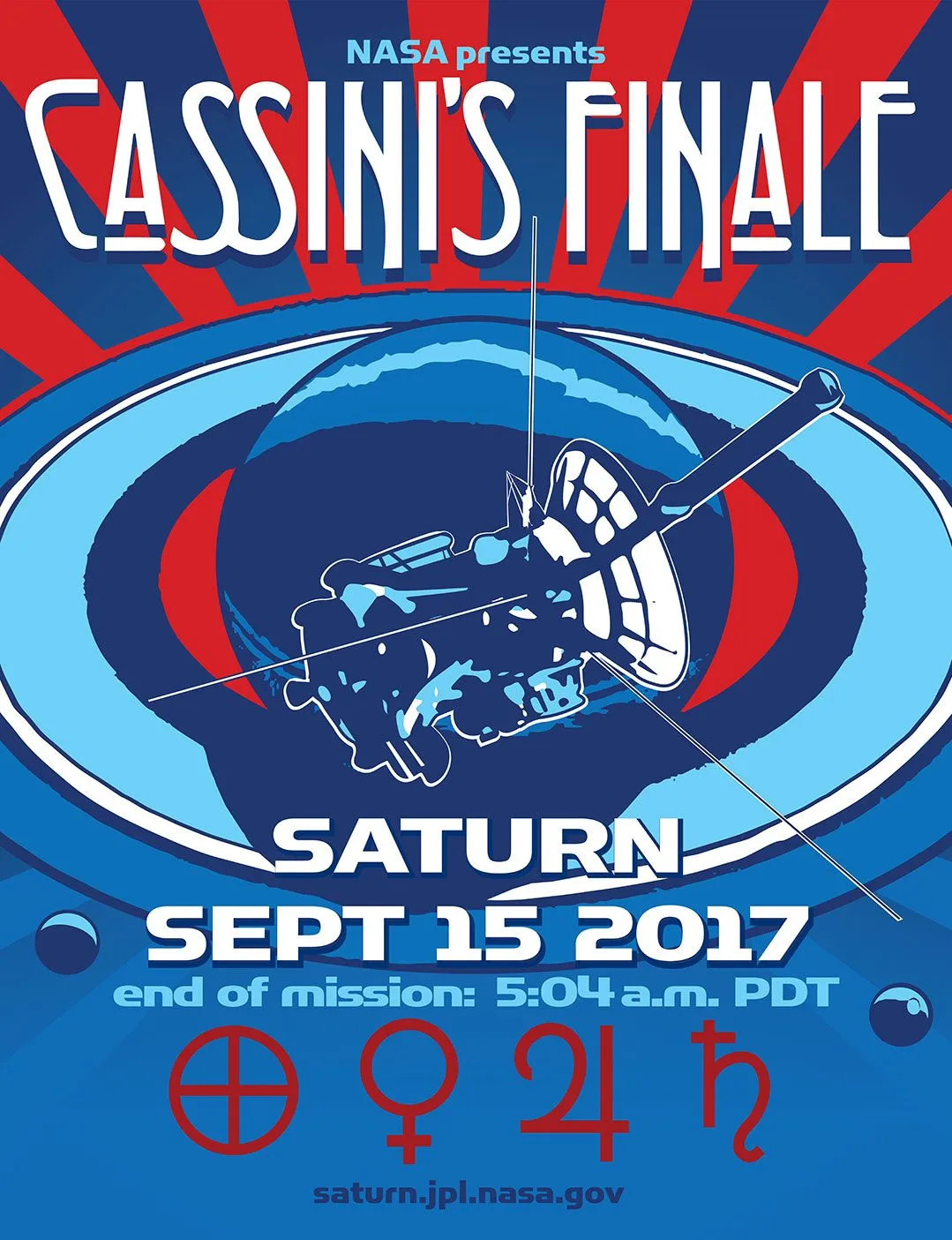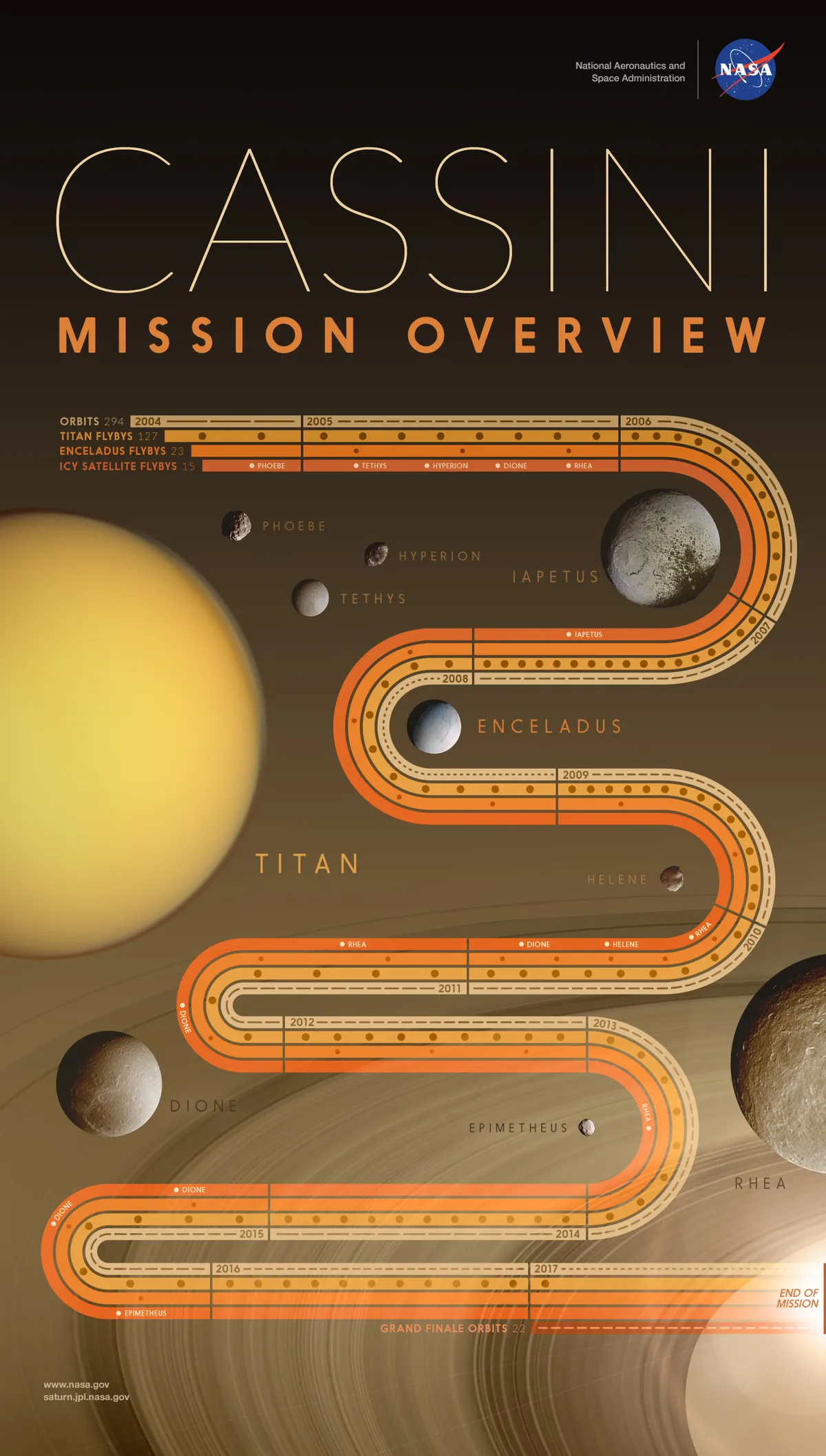It sounds like a scene from the ultimate disaster movie: speeding along at 113,000km/h, a $1.5bn vehicle the size of a bus plummets into a foggy abyss. Within a few brief minutes, it is shattered into pieces by built-up pressure, its delicate parts vaporised by frictional heat. It’s a dramatic end to what has been hailed as the most successful exploratory space mission in human history. Surprisingly, this Friday’s fatal plunge is no accident. After studying Saturn for more than 13 years, the Cassini spacecraft will be deliberately sent into a trajectory, burning up in the giant gas planet’s atmosphere.
Mission accomplished
“It has been an incredible mission,” says project scientist Linda Spilker of NASA’s Jet Propulsion Laboratory in Pasadena, California. “Cassini has rewritten the textbooks on Saturn.” So why destroy it? The exciting answer: to protect possible microbial life on Saturn’s moons. According to Spilker, Cassini’s small thrusters have almost run out of fuel, so the craft will be soon be impossible to steer. If the craft is not destroyed, it could crash into the moon Enceladus, contaminating its subsurface ocean – one of the most promising environments in the Solar System for finding extraterrestrial life.
Thanks to its majestic system of rings, Saturn is considered by some to be the Solar System’s most beautiful planet. Over 35 years ago, the gaseous giant was briefly glimpsed during fast flybys of three earlier spacecraft – Pioneer 11 and the two Voyager probes. But Cassini, launched in October 1997, has a permanent view from its elliptical orbit around Saturn. Ever since its arrival on 1 July 2004, its suite of instruments has studied the planet’s atmosphere, ring system and retinue of satellites. Some 130 close encounters with Titan, Saturn’s largest moon, were staged in such a way that Titan’s gravity deflected the spacecraft towards close encounters with other moons.
The most awe-inspiring legacy of the Cassini mission is its collection of almost 400,000 photos. While every picture contains a wealth of scientific information, many of the eye-catching shots – including surrealistic views of the ring system, stark images of light and shadow, and serene shots of multiple moons – were taken at least partly for aesthetic reasons. “My favourite one was taken on 19 July 2013, when the Sun was behind Saturn as seen by Cassini,” says Spilker. A minute speck of light in the eerie photo is actually planet Earth. “The remote view of this tiny world helps you to put things in perspective,” she adds. You can see some of the most amazing photos here.

Because of its distance from the Sun and its lower temperature, Saturn’s clouds form at a deeper level in the atmosphere than Jupiter’s, rendering them less striking. Still, during almost half of Saturn’s seasonal cycle, Cassini successfully snapped pictures of wavelike patterns, numerous small eddies, and even a giant storm system at mid-northern latitudes that recurs once every Saturnian year. Atmospheric scientists were stunned by the churning vortices and maelstroms at the planet’s poles – persistent cyclones 20 times larger than their terrestrial counterparts – and by the giant hexagonal pattern of standing waves surrounding Saturn’s north pole.
Over the moon
Even more exciting was Cassini’s step-by-step exploration of the surface of Titan. The huge moon is covered in smog, but infrared cameras and radar instruments managed to image and map shifting sand dunes, ice volcanoes, mountain ranges and even patchy networks of lakes, filled with liquid hydrocarbons like methane and ethane. The European Huygens probe that hitched a ride to Saturn with Cassini and soft-landed on Titan in January 2005 provided valuable data about the moon’s surface. It discovered that Titan is a frigid and swampy environment, rich in organic compounds. It is battered by massive storms of methane rain, and littered with pebbles and boulders of frozen water. In other words, Titan is a science-fiction writer’s paradise.
Other moons turned out to be no less bewildering. Take Hyperion, for instance, that’s as porous as pumice. Or tiny Pan, orbiting within one of the gaps in Saturn’s rings and shaped like a flying saucer. Or Mimas, known as the Death Star moon because of its giant circular impact blemish. And don’t forget mysterious Iapetus, the yin-yang moon with one dark and one bright hemisphere, which sports a 20km-high ‘mountain range’ of collected debris on its equator.

Still, nothing can beat Enceladus. From cracks near the south pole of this small frozen moon (it measures just 500km across), geysers of dust, water vapour and ice crystals spew into space – proof of the existence of a subsurface ocean. Tidal friction from Saturn heats up the interior, producing hydrothermal vents at the ocean floor. On Earth, similar underwater vents teem with weird forms of life that rely on chemicals instead of sunlight. Who knows what organisms might thrive beneath the surface of Enceladus. “The 23 close flybys of this tantalising moon have hugely changed our thoughts about the best way to look for extraterrestrial life,” says Spilker.
Lord of the Rings
Of course, much of Cassini’s time has been devoted to studies of Saturn’s iconic ring system. Despite measuring roughly 273,000km across, the average thickness of the rings is just 20m. Gravitational interactions with embedded moonlets produce narrow gaps, tightly-wound spiral waves, propeller-shaped disturbances, clumps and kinks, and even vertical ‘walls’ of uplifted ring material, casting dramatic shadows during Saturn’s equinox. Yet scientists are still unsure about the age of the ring system: did it form billions of years ago, at the same time as Saturn, or is it the scattered debris of a recently shattered moon?

It’s one of the puzzles the Cassini team have been trying to solve, with early indications suggesting the rings are only 100 million years old. Since April, the intrepid spacecraft has been performing a series of staggering dives through the 2,000km-wide gap between the planet’s cloud tops and the inner edge of the rings. By precisely tracking Cassini’s path, it was able to ‘weigh’ the rings for the first time ever. “If they’re low-mass, they can’t be old, or they would’ve been eroded away by micrometeoroids long ago,” says Spilker. The daredevil dive manoeuvres also yielded the most detailed views of Saturn’s atmosphere, its tiny inner moons, and, of course, of the rings themselves.
Speaking about the mission coming to a close, Spilker says: “It’s probably going to be a weird mix of happiness and sadness. There will be applause and toasts, but also grief and tears. Maybe the biggest feeling of loss will be about the disbanding of the Cassini team – many of us have devoted a large part of our lives to this mission, and we’ve become one big family.”
NASA's Cassini Spacecraft: A Journey's End(NASA Jet Propulsion Laboratory/YouTube)
This extract first appeared in issue 310 of BBC Focus magazine - for the latest science news, discoveries, innovations and Q&As subscribe here.
Follow Science Focus onTwitter,Facebook, Instagramand Flipboard
